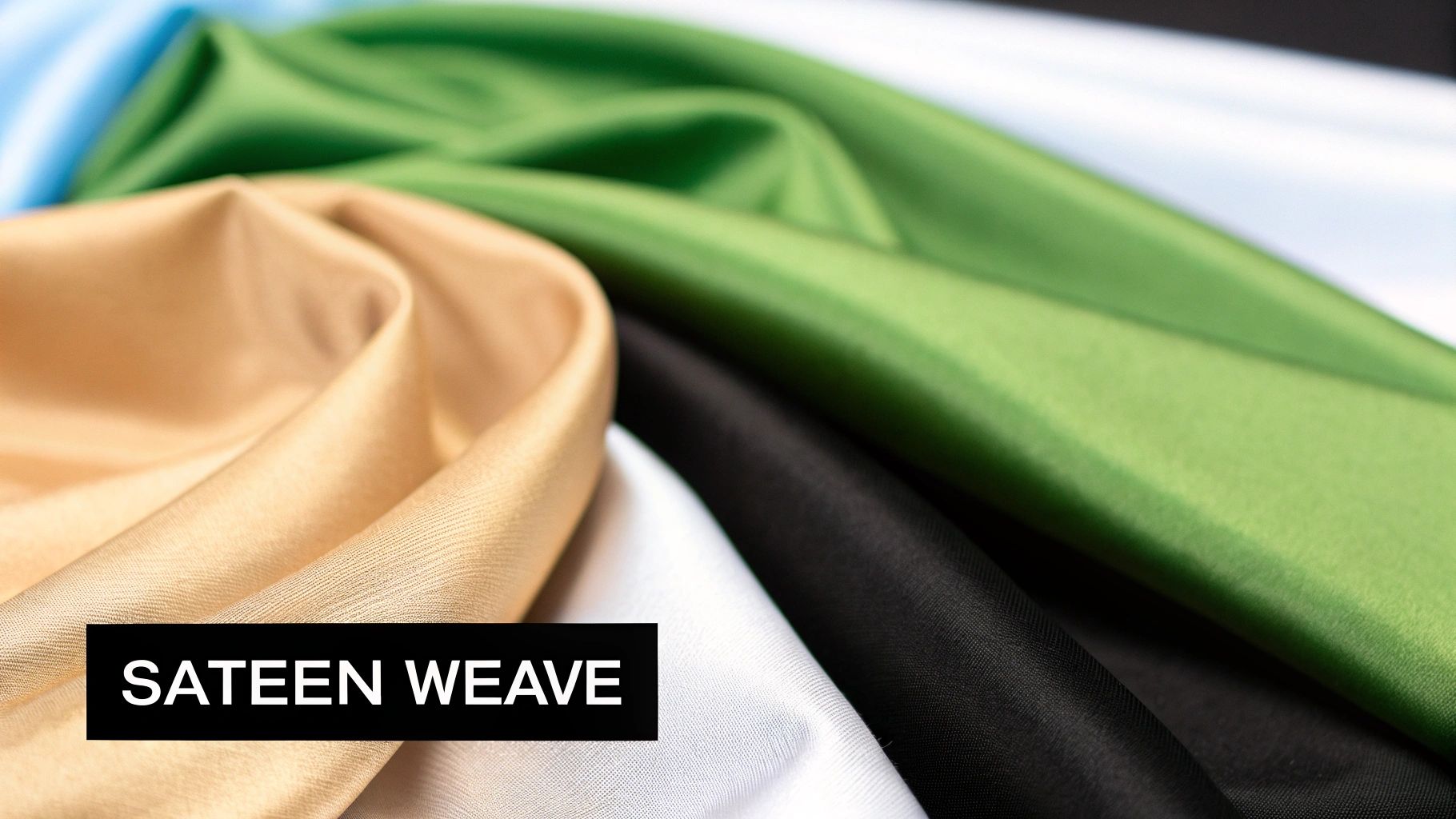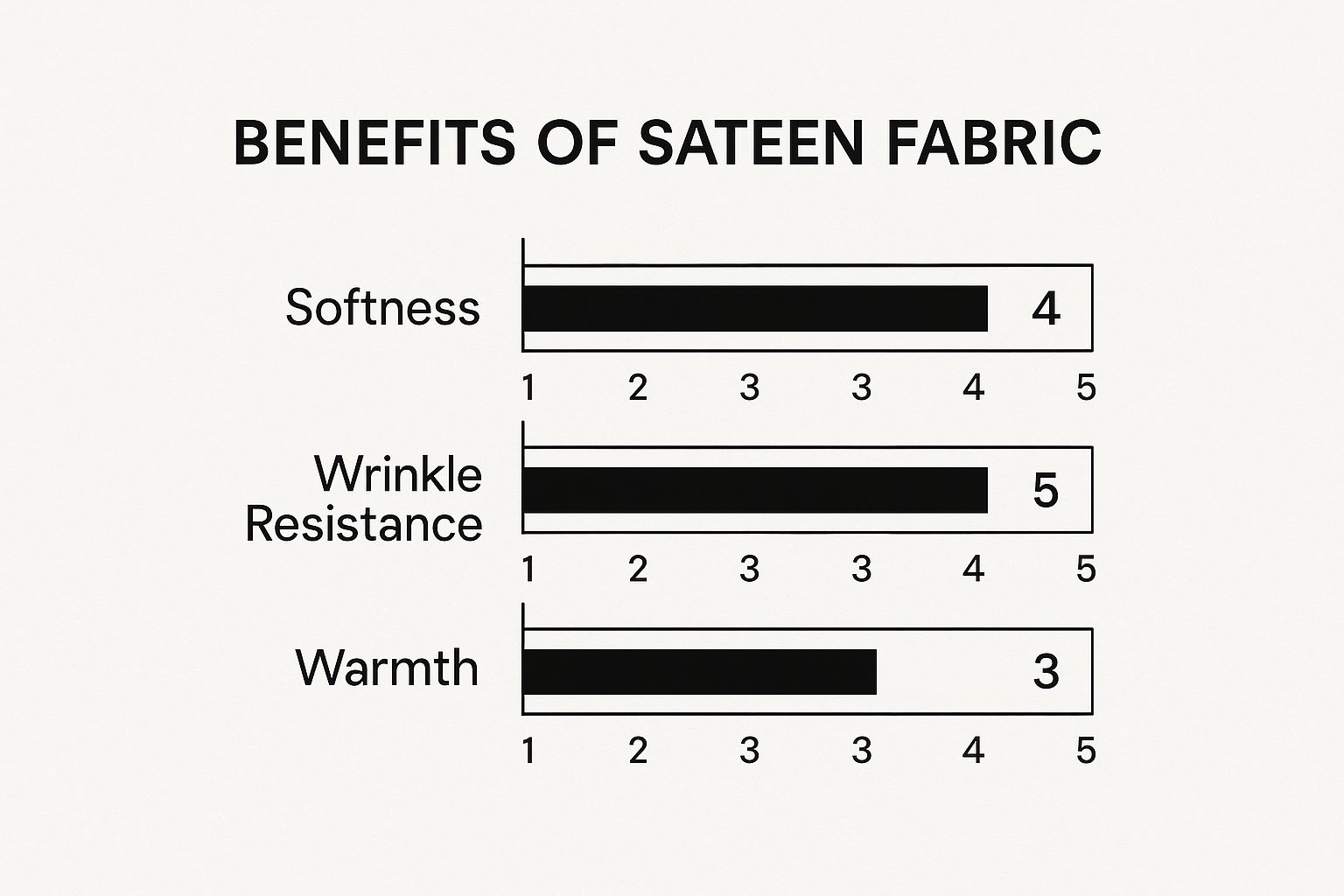Let's clear up one of the biggest myths in the world of bedding. Sateen is not actually a material like cotton or linen. It is a specific style of weave, and this unique structure is what gives the fabric its famously silky, luxurious feel. The result is bedding that feels incredibly cosy, is gentle on the skin, and looks effortlessly elegant.
Understanding the Sateen Weave
So, what exactly is sateen, and what makes it feel so special? The secret is all in the clever way the threads are woven together.
Picture a simple grid of threads. A standard weave often uses a simple one thread over, one thread under pattern. Sateen, however, does something different. It uses a four over, one under structure, meaning one vertical thread floats over four horizontal threads before tucking under just one.

This simple but effective change exposes more of each thread's surface, which creates sateen’s signature subtle sheen and buttery soft touch. It’s almost always made from 100% cotton, so you get all the natural comfort and breathability of cotton, just with a much more lavish drape and feel.
This specific weave contributes to a soft, lustrous fabric prized in the UK's textile industry, which is valued at around £5.8 billion for material production alone. You can find more insights into the British textiles market on UKFT.org.
Key Characteristics of Sateen
Sateen's distinct weave gives it several appealing qualities that make it a firm favourite for high quality bedding. Understanding these characteristics helps explain why it feels so different from other cotton sheets.
- Silky Soft Feel: The remarkably smooth surface glides over your skin, rather than feeling crisp or coarse.
- Subtle Sheen: It has a gentle, pearly lustre that looks elegant and inviting, without being overly shiny like traditional satin.
- Wrinkle Resistant: The fabric's fluid structure means it is naturally less prone to creasing, which helps your bed look tidier for longer.
This combination of softness and practicality makes sateen an excellent choice when you are deciding on the best material for your bed sheets.
The Unique Comforts of Choosing Sateen
So, what is it about sateen that makes people choose it time and again for their bedding? It’s not just about how it looks. It is about the tangible experience of slipping into bed each night and feeling that unmistakable comfort.

The first thing you’ll notice is its exceptionally soft, smooth feel. Unlike crisp fabrics, sateen glides against the skin, giving it a truly luxurious quality. This silky texture is not an accident. It is a direct result of that four over, one under weave, which lets more of the soft cotton fibres sit right on the surface.
Another practical perk is that sateen is naturally more wrinkle resistant than other cotton weaves. Its fluid drape means it creases less, both in the wash and on your bed. This helps your bedroom look effortlessly tidy and inviting.
A Cosy and Comforting Drape
One of sateen's standout features is its slightly heavier weight, especially when you compare it to something like percale. This gives the material a beautiful, comforting drape that feels fantastic on cooler nights or for anyone who just loves that feeling of being gently cocooned while they sleep.
This comforting weight adds to the sense of luxury and can make your whole bed feel more premium. It’s an important piece of the puzzle when you are figuring out how to make your bed more comfortable.
The gentle weight and beautiful drape of sateen not only look elegant but also provide a comforting, cocooning sensation that can help you relax more deeply at night.
If a soft, snug sleeping environment is what you’re after, sateen strikes the perfect balance between warmth, breathability, and pure opulence. It really does transform your bed from just a place to rest into a proper sanctuary.
In short, the main advantages are clear:
- Silky Smooth Texture: It feels incredibly soft and gentle against your skin, bringing a bit of everyday luxury.
- Wrinkle Resistant Finish: Sateen stays looking smooth and neat on your bed with minimal fuss.
- Cosy, Comforting Weight: It offers a reassuring drape that’s ideal for year round comfort, especially on cooler evenings.
Ultimately, choosing sateen is about elevating both your sleep quality and your bedroom's aesthetic in one simple step.
Choosing Between Sateen and Percale
When it comes to cotton bedding, the conversation almost always lands on two key players, sateen and percale. This is the classic bedding debate, and honestly, the right answer boils down to what you find most comfortable. It’s a bit like choosing a favourite jumper. One might be light and airy, while the other is soft and wonderfully cosy.
Percale is what you’ll often find in a high end hotel. It’s known for that crisp, cool feel and a classic matte finish. This texture comes from a simple one thread over, one thread under weave. This structure allows air to circulate freely, making it a fantastic choice for warmer nights or for anyone who tends to sleep hot.
Sateen, on the other hand, delivers a completely different experience. It’s silky, exceptionally soft, and feels a little heavier and warmer against the skin. Its signature subtle sheen gives it a more luxurious and inviting look, perfect for turning your bedroom into a cosy retreat.
Feel and Appearance
The most immediate difference you will notice is the texture. Percale feels light and crisp, almost like a freshly pressed shirt, and it has the lovely quality of getting softer with every wash. Sateen feels buttery smooth right from the start, draping beautifully over the body for a comforting, snug feel.
This infographic neatly sums up sateen's key benefits of softness, wrinkle resistance, and warmth.

As you can see, sateen really shines when it comes to providing a soft, warm, and low maintenance sleeping experience.
To make the choice a little easier, here’s a quick side by side comparison.
Sateen vs Percale at a Glance
A clear comparison to help you choose the right cotton weave for your sleeping style.
| Feature | Sateen | Percale |
|---|---|---|
| Feel | Silky, smooth, buttery | Crisp, cool, light |
| Appearance | Subtle, luminous sheen | Matte, flat finish |
| Temperature | Warmer, ideal for cooler months | Breathable, great for warm sleepers |
| Durability | Slightly less durable due to floats | Very durable due to tight weave |
| Best For | Those seeking cosy, luxurious softness | Those who love a fresh, hotel feel |
Ultimately, neither weave is inherently better. It is all about what feels right for you.
Deciding Which Is Right for You
So, how do you make the final call? Your perfect bedding is the one that helps you get your best night's sleep.
- Choose Percale if you: love a crisp, cool feel, tend to overheat at night, or live in a milder climate. It is the go to for that "fresh hotel bed" feeling every single night.
- Choose Sateen if you: prefer a silky, soft touch, enjoy a cosier and warmer bed, or want sheets that naturally resist wrinkles and look effortlessly elegant.
Remember, the quality of the cotton and the thread count also have a huge impact on the final feel. If you want to dive deeper, you can explore our guide on the best thread count for sheets. Understanding what sateen is helps you appreciate its unique qualities, but putting it head to head with percale ensures you find the perfect match for your sleep style.
Understanding Sateen vs Satin
It is one of the most common mix ups when shopping for new bedding, but the difference between sateen and satin is actually quite straightforward, and very important. Their names sound alike, and they both have that lovely lustre, but how they feel, breathe, and wear all comes down to one thing: the fibre.
At a glance, both fabrics share a similar weave that gives them that beautiful, subtle sheen. The real distinction lies in what’s actually being woven. Sateen is made from spun yarns, almost always 100% cotton. This means you get that sought after silky look combined with all the practical perks of a natural fibre.

Classic satin, on the other hand, is woven using long, continuous filament fibres. Historically this was luxurious silk, but today it often involves modern synthetic materials like polyester. This is what gives traditional satin its signature high gloss, slippery surface.
Why the Fibre Matters Most
This fundamental difference in fibre completely changes how the fabric behaves. Cotton sateen really does offer the best of both worlds, pairing a satin like smoothness with the practical, familiar advantages of cotton.
- Breathability: Being a natural material, cotton allows air to circulate freely. This helps regulate your body temperature for a comfortable night's sleep, whereas synthetics like polyester are known for trapping heat.
- Feel on Skin: Sateen's cotton foundation feels wonderfully soft and gentle. In contrast, polyester satin can sometimes feel clammy or less pleasant against the skin.
- Durability and Care: Cotton sateen is generally far more durable and much simpler to look after than delicate silk satin, making it a more practical choice for everyday life.
The growing demand for natural fibres speaks for itself. The UK satin fabric market is projected to see steady growth, with a compound annual growth rate of around 5.3% from 2024 to 2031. This trend is largely fuelled by people seeking out natural fibre alternatives like cotton sateen for their superior quality and comfort. You can explore more data about the satin fabric market trends on cognitivemarketresearch.com.
Choosing sateen means you don’t have to compromise. You get the elegant look of satin with the breathable, easy to care for qualities of high quality cotton.
Ultimately, sateen strikes a perfect balance, making it a fantastic and practical option for anyone who wants both elegance and everyday comfort in their home. If you'd like to see more, you can discover a wonderful selection of luxurious bed linens in our journal.
How to Care for Your Sateen Bedding
Keeping your sateen sheets feeling buttery soft and looking beautiful is wonderfully straightforward. With the right care, you can maintain their luxurious quality for years, ensuring every night feels just as cosy as the first.
The golden rule for sateen? A gentle touch. When it’s time for a wash, opt for a gentle cycle using cool or warm water. High temperatures can be a bit harsh on the delicate cotton fibres over time, so this simple switch helps preserve that signature smooth surface.
Washing and Drying Tips
A little extra attention during laundering really pays off, helping to prevent pilling and keeping your sheets feeling divine.
- Choose a Mild Detergent: Harsh chemicals and sateen do not mix. A gentle, pH neutral detergent is the perfect choice to protect the fabric's softness.
- Skip the Fabric Softener: It might seem counterintuitive, but fabric softeners can leave a residue on the fibres, which actually diminishes their softness and breathability.
- Tumble Dry on Low: The best way to dry your sheets is on a low heat setting. Pull them out as soon as the cycle finishes to stop wrinkles from setting in.
- Line Dry When Possible: If you can, line drying is a fantastic, even gentler option. It’s a great way to preserve the fabric's natural lustre.
These simple guidelines are quite similar to our advice in the Snuggle Comforter care guide, which has even more tips for looking after your favourite bedding.
Your Sateen Questions, Answered
To help you feel completely confident in your choice, we’ve put together clear, simple answers to the most common questions people ask about sateen bedding. This is the final piece of the puzzle, designed to clear up any lingering doubts you might have.
Is Sateen Good for Hot Sleepers?
This is a really practical question, and the honest answer is: it depends on you. While sateen is woven from naturally breathable cotton, its tighter weave makes it a little less airy than something like percale. The result is a warmer, cosier feel.
If you know you run very hot at night, the crisp, cool nature of percale might be a better fit. That said, for most of us here in the UK, sateen strikes a beautiful balance. It is perfectly comfortable all year round, offering just the right amount of snug warmth without making you feel stuffy.
Does Sateen Fabric Pill Easily?
Pilling, those annoying little bobbles of fabric, is a common worry, but it’s not something you should expect from good sateen. High quality sateen is made using long staple cotton, and those long, smooth fibres are naturally resistant to breaking and tangling, which is what causes pilling in the first place.
You are far more likely to see pilling on fabrics made with shorter, lower quality fibres. To keep your sateen bedding looking and feeling perfectly smooth, just follow the care instructions. A gentle wash cycle, avoiding rough items like towels, is all it takes.
What Is the Best Thread Count for Sateen Sheets?
It is a common myth that a higher thread count automatically means better sheets, but that’s not always the full story. When it comes to sateen, the sweet spot is generally a thread count between 300 and 600.
A thread count in the 300 to 600 range offers the perfect balance of buttery softness, lasting durability, and comfortable breathability. Remember, the quality of the cotton fibre itself is always more important than an inflated number.
So, instead of getting caught up chasing the highest number, focus on finding well made sateen within this ideal range. It’s the best way to get that luxurious feel sateen is famous for, without sacrificing the practicality needed for everyday family life.
At Morgan and Reid, we believe that the right bedding can turn your sleep into a truly restorative experience. Discover our collection of irresistibly comfortable comforters and bedding essentials, designed to bring modern style and cosiness to your home. Explore our range at https://www.morganandreid.com.



Share:
Finding the Best Bed Sheet Material for You
Smart Bedroom Storage Solutions to Reclaim Your Space